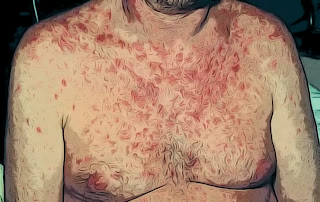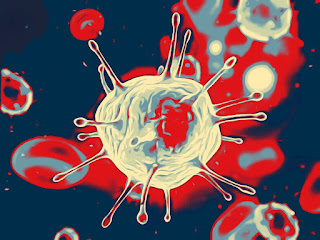It is a good idea to get tested for HIV / AIDS at least once a year. If you want to know if you have HIV / AIDS or need to check your HIV status, your doctor or STD clinic can help. They detect physical symptoms and check the results of your blood. If you are not sure if you have HIV or not, a home blood test or saliva test. Careful testing can manage all potential complications in a timely and effective manner, as well as preventing disease transmission.
Procedure 1 of 4:
Knowing the signs and symptoms of HIV / AIDS
1. Look for mild flu-like symptoms within a month of sexual intercourse. These include fever, headache, muscle aches, rash, sore throat or swelling of the nodes in the neck. These symptoms usually appear within 2 months after infection. These are usually the first signs that you have HIV. Many people become infected with HIV unconsciously or without symptoms after risky sexual activity or unprotected sex. Practice safe sex to reduce your HIV risk.
2. Check for wounds, bumps or rashes on the skin. As HIV progresses to AIDS, you may develop certain skin conditions. Check your tongue, scalp and body for unusual rashes, marks or discoloration. Common skin conditions in people with AIDS include:
Kaposi's sarcoma: a type of skin cancer that resembles many red, black, or purple marks growing on the skin. HIV-related herpes: red blisters on the mouth or genitals. Oral hairy leukoplakia: white hairy spots or rash on the tongue. Molluscum contagiosum: a condition that causes hundreds of pink spots on the body. Many of them are later stage symptoms that may be completely absent.
3. Check for any recurring illness or infection. By the time your body develops AIDS, your immune system is more weakened. That means you get sick more easily. Recurrent pneumonia or bronchitis may occur. See a doctor if you are constantly ill or have an infection. Common recurring symptoms are:
fever
Diarrhea
Night sweats
fatigue
Weight loss
Procedure 2 of 4:
He underwent medical tests
1. Visit your doctor or HIV clinic for testing. These tests can be performed by your doctor or physician. If you want to be tested anonymously, find your local public STD clinic online that accepts patients without the need for personal information. The US HIV Testing Center can be found here: GET TESTED TODAY. Small towns do not need a specialized HIV clinic. The STD Community Clinic will be able to perform similar tests. 2
From physical examination. Your doctor will look for symptoms to see if you are showing physical signs of AIDS. They may also ask you about your sexual history. Tell your doctor in a simple but informative way about any unprotected sex you may have, especially if it involves multiple partners. Your doctor will usually look for swollen lymph nodes, skin lesions, sound in your lungs and abdominal distension (inflammation). Your doctor should know your sexual history and whether you have sex with someone who has HIV / AIDS. Also tell your doctor about using medication needles. This is a common way of spreading HIV.
3. Got and test saliva. Speech tests can be performed by a doctor. Your doctor or nurse will run a test strip over your upper and lower limbs. In most cases, the results are tested directly at the office. After 20 minutes, your doctor or counselor will let you know if you are positive or negative and give you treatment options. If you are taking the OraQuick In-Home test and it is positive, tell your doctor. They can skip this test and perform a blood test.
4. Make a blood test. Unlike a complete blood test, a blood test can be performed in a doctor's office, usually within 30 minutes. The doctor will stab you in the finger and take the blood. This test is usually performed to determine if further testing is required. If it is positive, your doctor will probably ask you to take a whole blood sample.
5. Have your blood tested for the virus. Your doctor will take a blood sample and send it to the laboratory. The lab will perform many different tests on your blood to look for a virus in your blood. These tests include:
Antibody tests, antibody search for 3 weeks after infection. Combined tests that look for HIV / AIDS antibodies and antigens. The virus recognizes 2 weeks after infection.
Western blot, performed after a blood test to check that the first test is good.
6. If you are positive, check your HIV status with regular blood tests. These blood tests (known as viral load and CD4 tests) measure how much virus is in your blood. The higher the viral load in your blood, the faster the number of CD4 cells decreases, which may affect your immune response. This will help you check your condition to see if your HIV can turn into AIDS. These tests should be performed every 3-4 months if you are not receiving antiretroviral therapy. If so, you may need these tests every 3-6 months. Consult your doctor for more information.
After your first HIV infection, it can take up to 10 years for you to become AIDS. With new advances in treatment it may be even higher.
7. If your test is negative, try again after 3 months. The development of anti-HIV antibodies can take up to 3 months to appear in the test. If the first test is negative and you have a high risk, you can return in 3 months to be sure.
Procedure 3 of 4:
Make a blood test at home
1. Buy Home Access HIV-1 Test System at pharmacy or online. This is the only domestic blood kit approved by the FDA for HIV / AIDS testing. The set includes a lancet, bandage, alcohol pad and blood collection card.
Always read the instructions provided with the home test before you begin. For example, if you have had unprotected sex with someone who has recently had HIV, or if your former partner has admitted to being infected with HIV, you should take the test again after 3 months.
2. Call the subscription card number. Follow the instructions on the phone to register your test. They will ask for the access code number on this card. Download and save this part of the map so you can access the results later. Enter the date and your access number in the appropriate fields on the remaining card. The melting pot can be harmful if you are not mentally strong. You'd better visit the clinic.
3. Wash your hands. Use hot water to kill bacteria and increase blood circulation. When your hands are dry, place them from your wrists to the fingers of the hand you will be piercing. Then remove 1 finger and wipe it with an alcohol swab.
4. Sew your finger. Place the lancet on a flat surface and continue with your finger until it clicks. Wait for a drop of blood to form, and slowly place the drop against the circle on the card. Do not wipe or push the card with your finger. Place additional drops on the side until the circle is full. If a drop of blood does not form, keep your hand down. Massage your hand from wrist to finger until no blood is visible. After sticking, put the bandage on your finger. Be sure to place three on one side, not one on the other.
5. After 7 working days, call the tear-off card number. Before they give you the results, they will ask you to print a passcode on the card. The laboratory will perform two rounds of tests needed to diagnose HIV / AIDS. This means that if your first test passes, they will take a second test. If the test is positive, consult a doctor as soon as possible.
Procedure 4 of 4:
Run a saliva test at home
1. Purchase OraQuick In-Home HIV Test at pharmacy or online. This test is the only saliva test that can be performed at home. This test consists of a plastic test stick, a test tube with fluid and an instruction booklet.
2. Wash the scalp with a test strip. Insert the stick into the upper hole once and into the lower hole once. Make sure you ride the whole gomline. Do not ride the stick more than once along the gum line.
3. Insert the test strip into the tube. Open the tube firmly. If the liquid leaks, throw it away and buy a new test. The plastic tip that touches your piercing should fall into the fluid. The test window remains outside the tube.
4. After 20 minutes. First, the test window will be pink. This indicates that the test is working. After 20 minutes, compare the lines in the test window with the results in the booklet. Do not wait longer than 40 minutes to read the test window, otherwise the results may expire.
Line next to C for negative result. You do not need to see a doctor. If there are 2 rows, 1 next to C and 1 next to T, this result is positive. You should see a doctor for further tests. No line indicates that your test kit is not working. You may need to buy a new one.
5. Meet your doctor if you are positive. Your doctor will perform blood tests to make sure the result is correct.





Post a Comment
Leave a comment